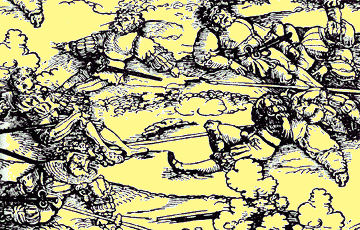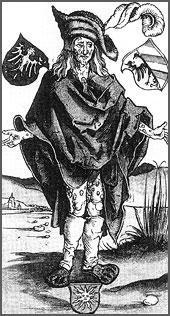 |
"A
sort of internal disturbance became obvious" |
 As
many histories have pointed out, communities even under the best of
conditions during this period were hit by diseases. People
then simply had the perception that diseases appeared, even spread, and
vague notions about how. Causes were offenses against
God, witches, moist night air, imbalanced humors and eating too much fruit.
Germ theory did not come until the 19th century (along with
effective anesthetics). Beyond their grasp was any notion of
disease vectors, like lice and fleas; the bodies of many
harbored these nippy parasites. Basic concepts of sanitation and
disease prevention eluded people, such as not having the latrine located close to
the water source.
As
many histories have pointed out, communities even under the best of
conditions during this period were hit by diseases. People
then simply had the perception that diseases appeared, even spread, and
vague notions about how. Causes were offenses against
God, witches, moist night air, imbalanced humors and eating too much fruit.
Germ theory did not come until the 19th century (along with
effective anesthetics). Beyond their grasp was any notion of
disease vectors, like lice and fleas; the bodies of many
harbored these nippy parasites. Basic concepts of sanitation and
disease prevention eluded people, such as not having the latrine located close to
the water source.
 Any army settling in for a siege or defenders finding themselves cooped up
within fortifications suffered their lack of sanitation accumulating around them
and soon had their numbers afflicted with what they loosely
termed "camp fever." That evidently was a catchall term for symptoms like
fever, skin eruptions and diarrhea, and associated diseases which ranged from
ordinary
food poisoning
to typhoid fever to
typhus to
pneumonia to ... etc...
Any army settling in for a siege or defenders finding themselves cooped up
within fortifications suffered their lack of sanitation accumulating around them
and soon had their numbers afflicted with what they loosely
termed "camp fever." That evidently was a catchall term for symptoms like
fever, skin eruptions and diarrhea, and associated diseases which ranged from
ordinary
food poisoning
to typhoid fever to
typhus to
pneumonia to ... etc...
It may not be a stretch to surmise that most cases of "camp fever" were indeed typhus, which is spread by lice, especially in filthy environments. While the onset of typhus may be so mild as to be shrugged off, "...the symptoms of malignant fever began to show themselves... a sort of internal disturbance became obvious, then prostration of the whole body, and a lassitude such as follows overexertion; the patient could only lie on his back, the head becomes heavy, the senses dulled, and in the majority of cases after the fourth or seventh day, the mind would wander... [and] red, or often purplish-red spots broke out on the arms, back and chest, looking like flea-bites..." so wrote the Veronese physician Girolamo Fracasoro in 1546. Soldiers stricken by typhus were obviously incapable of fighting.
Soldiers back then considered two diseases to be outside the category of camp fever: bubonic plague and syphilis.
It's an understatement to say the plague was well known and thoroughly feared at this time. Coming off ships at the port of Genoa in 1347, the plague burst across Europe like ignited gasoline. Radiating out from northern Italy, the plague jumped rapidly from area to area until it reached the periphery of Europe in 1351. Then it was as if it ricocheted back. Devastating flareups continued the remainder of that century, the worst being in the 1360's. By the New Year of 1400, the population of Europe was approximately half to two thirds of what it had been a century before (population loss was not only directly attributable to the disease but also to economic disruption and decline in the birth rate.) Although the population of Europe had recovered its numbers by the end of the 16th century, the plague remained the terror in the minds of all. Still around during this time period, erupting here and there as regional epidemics, it was not the big killer of soldiers and civilians during sieges. Certainly soldiers on the move carried the disease from one locality to another, but tales were not set down of entire armies or fortresses being wasted as cities were in the late 1340's.
 |
|
Soldier displaying the conspicuous symptom of syphilis: the boils, from which the disease derived its first name, the pox. Illustration by Albrecht Dürer, 1496. |
In 1494 syphilis, a.k.a. "the pox," had its first grand outbreak in the Kingdom of Naples, courtesy of the army of Charles VIII (remember that army and its artillery?). Sure that the disease was someone's else's fault, the French dubbed it the "Neopolitan Disease." (And in the same spirit of 'this is someone else's disease,' it went on to be referred to as the "Italian Pox," "French Pox," "Spanish Pox," "German Pox," and even the "Polish Pox" by those outside those regions - and finally the Turks claimed it was the 'Christian Disease.') About as quickly as the bubonic plague, syphilis spread across Europe, appearing in Nuremberg and Strassburg by 1495, Geneva and Paris in 1496 and England by 1497. Like its predecessor, the plague, the pox was particularly virulent on its first pass across Europe. "There were boils, sharp, and standing out, having the similitude and quantity of acorns, from which came so foul humors and so great stench, that whosoever once smelled it, thought himself to be infect. The color of these pustules was dark green and the sight thereof was more grievous unto the patient than the pain itself: and yet their pains were as though they had lain in fire." So stated Ulrich von Hutten in 1519 who contracted the pox as a soldier in Italy. For this disease, however, some keenly observant people made a correct cause-and-effect connection, attributing its spread to sex between infected persons and healthy ones. Since armies were (and still are) composed mostly of young men who yearned for diversion from military life, it is no surprise that soldiers acquainted themselves with women in new places, then marched on to different places, contracting/introducing the pox wherever they paused. In 1510, Dr. Fracasoro composed a poem in Latin describing the disease, for which he contributed the classical-sounding 'syphilis.'
Now, in the early 21st century, bubonic plague is a rarity, but syphilis remains a worrisome problem.
| Back | From Hell |
|
|
|